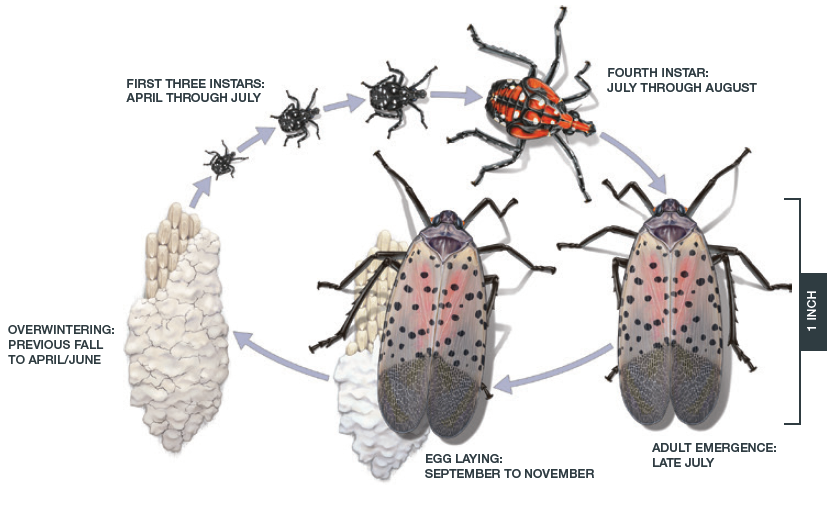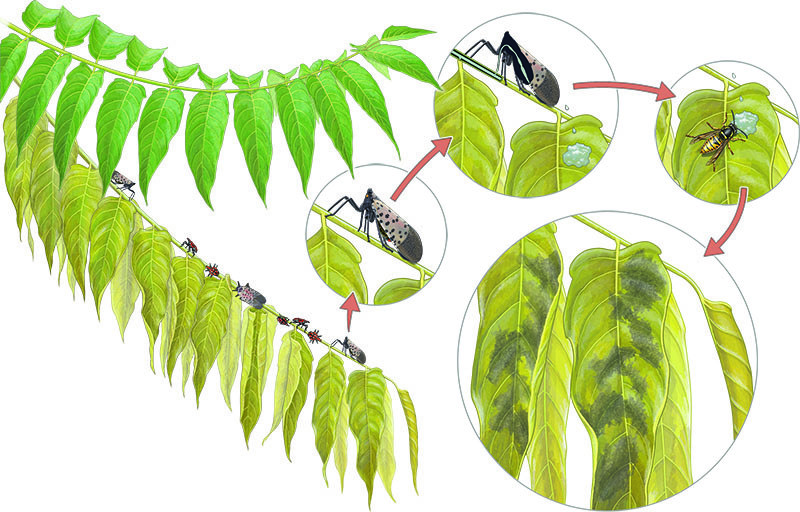Exterminators Winning the Race to Eradicate Spotted Lanternflies
June 20, 2022Spotted lanternflies: They are more colorful and attractive than most pests, so why are they so bad?
First, they are an invasive pest that feeds on a large variety of plant species, including those in the agricultural, timber, and ornamental industries, as well as backyard plants.
While they may not actually kill the trees they feed on, they are considered to be a plant stressor and may contribute to long-term weakening of established plants and trees. When combined with other stressors such as other insects, diseases, or weather, they can cause significant damage. They especially settle in grapevines and maple or black walnut saplings or trees.
As for their appearance, they belong to the insect family Fulgoridae, or planthoppers. This group of insects was named after “Fulgora,” the Roman goddess of lightning, because they were thought to be luminescent like lightning bugs. However, they are not!
Battling the spotted lanternfly in South Central Pennsylvania
The lanternfly eggs are laid in the fall of the year (September to November) and hatch in the spring (late April to June). In south central Pennsylvania, the adult flies begin to emerge in July and remain active as adults until they are killed by hard freezes later in the fall. The adult flies are large, about 1 inch in length, have black bodies, and are very mobile. Their forewings are gray with black spots, and the tops are black with gray veins, while their hind wings are red, black, and white.

How do spotted lanternflies damage trees?
Lanternflies feed on the sap of the tree or plant in which they reside, thus weakening the tree and making it more susceptible to disease or damage by other pests. The fly feeds through the bark of the tree, using a piercing-sucking mouthpart tapped into the plant like a straw.
When the spotted lanternfly digests the sap, it releases a honeydew or sugary water substance on and around its feeding site. This substance encourages the growth of a black sooty mold which is not harmful to humans, but can damage plants and make outdoor recreation areas unusable.
In turn, the combination of this honeydew mixture and tree sap serves as a magnet for other insects, particularly yellowjackets and hornets. Between the lanternflies and the stinging insects, you would be wise to consult a professional pest control service for treatment to make sure you are targeting both pests properly and not harming your landscape.

What do spotted lanternflies eat?
The menu of choice for the spotted lanternfly would be the sap of the Tree of Heaven and grapes, both orchard and wild grapes. Here in Pennsylvania, they also like apple and peach trees, basil plants, vegetables, and hops. They like many types of trees, including black walnut, maple, willow, and cherry trees. Although these plant varieties are the most common targets for the lanternfly, in all they have been known to attack more than 70 different plant species.
What species eat spotted lanternflies?
There aren’t a lot of ready volunteers in nature that are willing to devour the lanternfly. Birds don’t seem to like to eat them, and researchers have not yet found predatory or parasitic insects that are having a great impact on reducing the population.
A few general predators, such as praying mantis, assassin bugs, and spiders, have been observed eating spotted lanternflies. However, the fly population has been so extensive that the impact of those predators has not been significant. There have also been a few surprises noted among reports of other predators tackling the lanternfly. Among these are squirrels, bats, frogs, goldfish, and even a garter snake.
What do spotted lanternflies do at night?
Even busy bugs have to take a break! At dusk, the spotted lanternflies begin to congregate in large groups. They often gather on trees or other vertical surfaces, and can sometimes be seen swarming around street lights. While it is not clear exactly why they behave this way, it is thought that they may use light as a cue to help orient themselves or find mates.
It is hard to believe that we have been fighting to eliminate these pests in south central Pennsylvania since 2014, but that is when they first appeared in Berks County. They have since spread and are now present in 45 counties in Pennsylvania (including Lancaster, Lebanon, York), as well as eight additional surrounding states. The Pennsylvania counties are under a self-imposed quarantine designed to halt the spread of the infestations. Dominion Pest Control entered the battle against the sapsuckers in 2018 when they entered Lancaster County, and now treats more than 3,000 trees in Lancaster and York Counties.
The quarantine requires businesses that move property or goods in or out of the quarantined area acquire a permit and follow state-issued procedures to mitigate the possibility of giving the lanternflies free transportation to a new feeding ground.
On an individual level, Pennsylvanians can pitch in by learning to recognize the various stages of development of the lanternfly. If you find one or two on your property, there are probably hundreds more.
Exercise care when traveling to make sure you are not transporting the insects to other areas. An adult spotted lanternfly can stay attached to a vehicle moving at 65 mph, and egg masses that look like a splash of mud can be hidden on any surface easily blending in and moving with you anywhere your vehicle goes. Pennsylvania Department of Agriculture offers a checklist for residents to assist your efforts in this regard.
At Dominion Pest Control, we have treated many sites throughout south central Pennsylvania, both for the spotted lanternflies, and also the wasps and hornets that seem to follow. Northern Lancaster County seems to be somewhat under control in this ongoing battle, but York County and the southern part of Lancaster County are expected to have significant infestations this year. Contact us to obtain a quote for treating your property for spotted lanternflies on your trees, structures or decks.